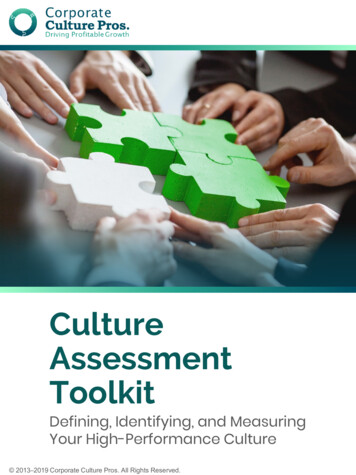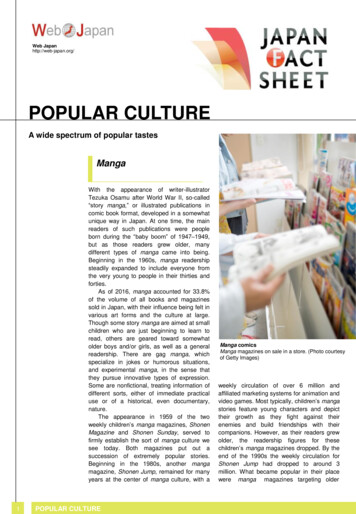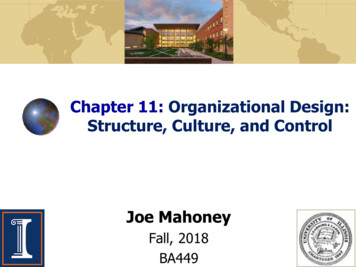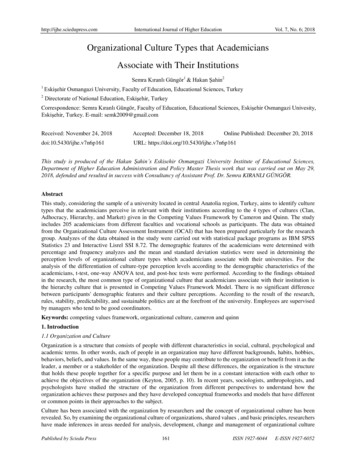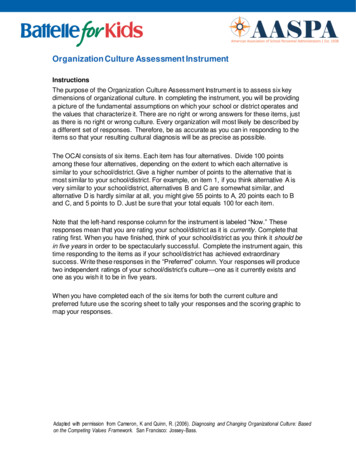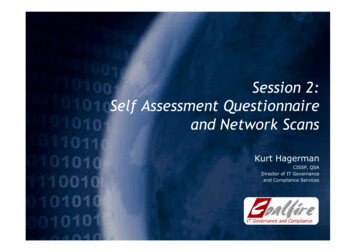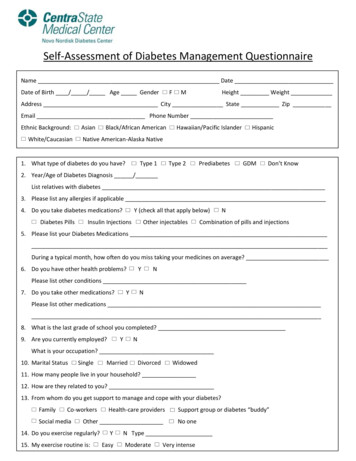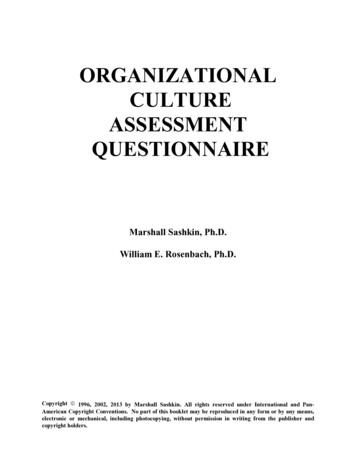
Transcription
ll Sashkin, Ph.D.William E. Rosenbach, Ph.D.Copyright ã 1996, 2002, 2013 by Marshall Sashkin. All rights reserved under International and PanAmerican Copyright Conventions. No part of this booklet may be reproduced in any form or by any means,electronic or mechanical, including photocopying, without permission in writing from the publisher andcopyright holders.
Organizational Culture Assessment QuestionnaireCopyright 1996, 2002, 2013 Marshall Sashkin, Ph.D.Page 2
Organizational Culture Assessment QuestionnaireOrganizational Culture Assessment QuestionnaireDimensionsThe Organizational Culture Assessment Questionnaire (OCAQ) is based on the work of Dr. TalcottParsons, a sociologist at Harvard. Parsons developed a framework and theory of action in socialsystems. He argued that all organizations must carry out four crucial functions if they are to survive forany substantial length of time. We have labeled these four functions managing change, achievinggoals, coordinating teamwork, and building a strong culture. One aspect of the way in whichorganizations achieve their goals is especially important, yet often neglected. This factor has beenmade into a separate, fifth scale: customer orientation.Each of the functions is supported (or, in some organizations, hampered) by the values and beliefs thatare shared by the organization's members. These values and beliefs are powerful forces fororganizational effectiveness--or for organizational failure. They are, however, most often unstated andunspoken; they are sometimes even actively concealed. But how can such abstract things as values andbeliefs determine whether an organization fails or prospers?Take, for example, the effectiveness with which an organization is able to deal with and managechanges in its environment--competition, technological changes, government rules and regulations, etc.If people in the organization believe that they can have little effect on or control over the environment,then they are not likely to invest much time or effort in trying to do so. In a purely objective sense itmay be that an organization can actually do very little to affect its environment. Still, whenorganization members share a strong belief that they can have some effect on their environment theyare likely to invest their energies in efforts that just might have some positive payoff. If they believeinstead that they can't have any impact, then it isn't relevant whether or not that's really true; they won'ttry. And, the result can be disastrous for the organization.Each of the five functional areas will be examined. We will be looking for values and beliefs that helpor hinder the organizational performance of these crucial functions.Managing Change. This area of action concerns how well the organization is able to adapt to and dealeffectively with changes in its environment. All organizations are open, to some extent, to influencesfrom their environments; that is what it means when we refer to organizations as "open systems." Thisfact has become even more obvious today, in times of rapid technological and social change, than itwas in the past. In earlier times it was possible to ignore the organization's environment and the effectsit had on the organization; this is no longer possible.We have already mentioned an especially important belief that seems to support managing changeeffectively: the belief that one is able to affect the environment (whether or not such a belief is trulyjustified). The opposite is also true: belief that it is impossible to have any effect on the environment islikely to hinder the effective management of change, since sensible people who believe they can havelittle impact on their environment will probably not spend much time or energy trying to do so.Copyright 1996, 2002, 2013 Marshall Sashkin, Ph.D.Page 3
Organizational Culture Assessment QuestionnaireScale I of the OCAQ assesses the degree to which respondents see the organization as effective inadapting to and managing change. The specific items ask about actual success in dealing with changeand about the presence (or absence) of the sort of positive values just described. The six statementsthat describe managing change are:Ø People are flexible and adaptable when changes are necessary.Ø People feel that most change is the result of pressures imposed from higher up in theorganization.*Ø People have a clear idea of why and how to proceed throughout the process of change.Ø Most people believe that change happens too quickly and causes too much disruption.*Ø People believe they can influence or affect their work place through their ideas andinvolvement.Ø People believe that their concerns and anxieties during periods of change are heard andtaken into considerations.*Reverse ScoredAchieving Goals. All organizations must achieve some aims or goals for clients or customers. Indeed,the role of the client or customer is so important that we have developed a separate scale to measurecustomer orientation. Having a clear focus on explicit goals has been proven repeatedly to have a verystrong relationship to actual success and achievement. Goal achievement is also facilitated when thegoals of the organization's members are "in line" or aligned with one another and with the overall goalsof the organization.What values or beliefs, then, can help an organization to achieve its goals? In terms of values,organizational achievement is supported by the basic value or need to achieve. That is, whenorganization members share the belief that it is important to be doing and achieving, this will help theorganization to attain its goals. Quite a lot of basic and applied research has shown that performance isgreater when people have a "need" to achieve, and that this need or belief can actually be learned as anadult. Another positive value is that of improving, in quality as well as performance; the Japanese callthis "Kaizen," the belief in a constant and never-ending search for improvement.The goal achievement function is measured by Scale II of the OCAQ, which asks respondents todescribe how effective the organization is in achieving goals, the extent to which there are coherent andshared (aligned) goals, and the degree to which shared values support improvement and achievementrather than the status quo. The six statements that measure achieving goals are:Ø Individuals and teams have clearly defined goals that relate to the goals or mission ofthe organization.Ø People and teams are often expected to reach goals which they believe areunattainable.*Ø Individuals and teams are measured and rewarded according to how well goals areachieved.Ø Individuals and teams participate in defining specific goals.Ø We constantly stretch our goals, to continuously improve.Ø Individuals, teams, and functional areas often have incompatible goals.*Copyright 1996, 2002, 2013 Marshall Sashkin, Ph.D.Page 4
Organizational Culture Assessment QuestionnaireCoordinated Teamwork. Long term organizational survival depends on how well the efforts ofindividuals and groups within the organization are tied together, coordinated and sequenced so thatpeople's work efforts fit together effectively. Because work efforts must "connect" and fit to form awhole, it is obviously ineffective when everyone believes it's OK to "do your own thing." What is lessobvious is that it can be equally counterproductive to attempt to have everything carefully planned fromthe top, down to the smallest detail. With work and the world becoming more and more complex, whatis needed are more effective ways of meeting unpredictable coordination demands, ways fororganization members to "mutually adjust" their actions to take into account unplanned and unpredictedcircumstances.Thus, in terms of the values and beliefs that support effective coordination, the value of collaborationand the belief that "we are in this together" (and must, therefore, work together to achieve common taskgoals) are important. In contrast, an especially unhelpful value is that of competition to see who can"do the best," independent of others. Of course, effective organizations do not simply ignorecompetition; they value competition, not internally but with other organizations. Within their own,internal cultures effective organizations typically emphasize the value of teamwork and cooperation.OCAQ Scale III assesses the extent to which an organization is effective in coordinating the work ofindividuals and groups. This scale also gets at the extent to which the shared value of collaboration ispresent. The six statements measuring coordinated teamwork are:Ø Teams often lack the authority needed to get the job effectively.*Ø People believe in teamwork, the “what’s in it for us” approach rather than “what’s in itfor me.”Ø People lack the interpersonal and technical skills they need to work effectively inteams.*Ø People know what is expected of them and understand their impact on other people,teams, and functions.Ø People believe in working together collaboratively, preferring cooperation overcompletion.Ø Managers at all levels work together as a team to achieve results for the organization.*Reverse ScoredCustomer Orientation. Earlier we noted that this aspect of organizational achievement is so importantthat it merits separate treatment and assessment. The organizational sociologist Charles Perrow hasexamined the nature of organizational goals. He observes that while organizations often have specificproduct or service goals--a standard of quality or a type of product or service for which theorganization is known--the crucial question is whether these internally-derived and defined goals matchor fit with what clients or customers want of the organization. No matter how strong the culture and nomatter how well the other functions are performed, if no one wants what the organization produces ordoes, then the organization is not likely to prosper.The values that support an effective customer orientation function are not simply an overriding belief inthe importance of the client or customer. Certain beliefs are associated with more and with lesseffective customer orientation strategies. For example, in some organizations people believe that theorganization should create new products and then try to develop customer demand. A rather differentstrategy is based on the belief that new products or services should be natural extensions of existingproduct or service lines. It is the latter and not the former belief that supports effective customerorientation.Copyright 1996, 2002, 2013 Marshall Sashkin, Ph.D.Page 5
Organizational Culture Assessment QuestionnaireScale IV of the OCAQ assesses the extent to which organizational activities are directed towardidentifying and meeting the needs and goals of clients and customers. The scale also examines theextent to which basic and strategic values that support an effective customer orientation are present.The statements assessing customer orientation are:Ø We give the highest priority and support to meeting the needs of clients and customersand solving their problems.Ø Our policies and procedures help us to provide the service our customers and clientswant and need.Ø People often see customer and client problems as someone else’s responsiblility.*Ø People are always looking for new ways to better serve clients and customers.Ø Employees who do the best job of serving customers are more likely than otheremployees to be recognized or rewarded.Ø When customers have problems with the products or services they receive, thoseproblems are almost always resolved to their satisfaction.*Reverse ScoredCultural Strength. All organizations have a "culture," formed out of the pattern of values and beliefsshared by some, most, or all of the organization's members. You can think of culture as a sort of a"fabric;" when there are many different values and beliefs, some shared by many people in theorganization and some shared by only a few, then the fabric is a sort of loose-knit weave, perhapssupported by a few critical, strong "warp" threads. However, when a certain group of values andbeliefs is strongly shared by most or all of the organization's members, then the resultant cultural fabricis more like tightly knit broadcloth, with a clearly visible design. The former sort of culture isinherently "weaker" than the latter; it is less likely to direct or channel the actions of organizationmembers. When the organization is faced with crises and must draw on all of its human and physicalresources, then a loose-knit, "weak" culture will be less functional in helping the organization tosurvive. A strong culture will provide greater stability of organizational functioning.It is important to remember that stability is not the same as effectiveness. It is not necessarily true thata "strong" culture, in which everyone strongly adheres to a clear set of common values and beliefs, willinevitably help an organization to survive and be effective. Whether a strong culture is also a goodculture, helping the organization to function and survive in the long run, depends on the sort of valuesand beliefs that form the cultural fabric. When the culture is based on values that do not support thefunctions of managing change, organizational achievement, customer orientation, and coordinatedteamwork--or when the values actually work against the effective performance of these functions--thena "strong" culture might actually hamper organizational survival. Or, to more aptly continue the fabricmetaphor, the culture will become a shroud rather than a suit.Scale V of the OCAQ assesses the strength of the organization's culture, asking respondents to reporton the extent to which people agree on values and examining the extent to which certain "meta-values"are present, such as the belief that people should support their views with facts. Of course, anorganization can conceiv
The Organizational Culture Assessment Questionnaire (OCAQ) is based on the work of Dr. Talcott Parsons, a sociologist at Harvard. Parsons developed a framework and theory of action in social systems. He argued that all organizations must carry out four crucial functions if they are to survive for any substantial length of time. We have labeled these four functions managing change, achieving .File Size: 232KBPage Count: 12
